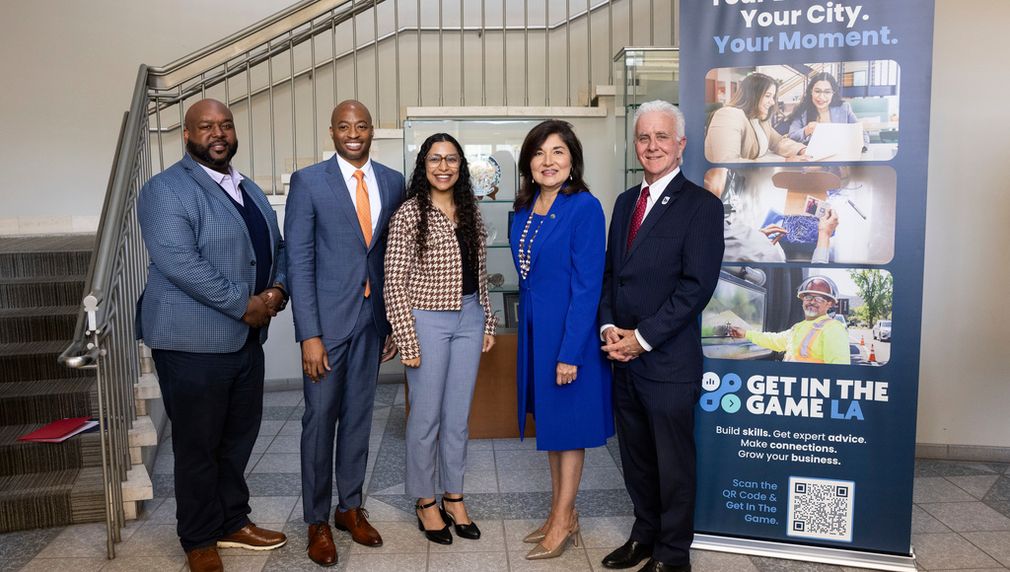Climate Resilient Vertical Farm
We aim to pilot a climate-resilient vertical farm in Long Beach to combat food insecurity and climate-driven crop failure. This innovative model will grow fresh produce indoors and sell it directly to the community through an on-site grocery hub, cutting supply chain costs and expanding food access in a historically underserved neighborhood. LA2050 funding will support the Design Phase of this project to bring this vision to life.

What is the primary issue area that your application will impact?
Health care access
In which areas of Los Angeles will you be directly working?
Long Beach
In what stage of innovation is this project, program, or initiative?
Pilot or new project, program, or initiative (testing or implementing a new idea)
What is your understanding of the issue that you are seeking to address?
Our project seeks to address a two-pronged problem: climate change on one hand and structural racism on the other. In LA County, this deadly combination has ultimately led to “Food Deserts,” or neighborhoods that do not have access to nutritious & affordable food. Climate warming is leading to global crop failure, as plants cannot withstand the heating temperatures. On the other hand, structural barriers have meant that current farming supply chains do not reach the most underinvested communities, leaving these residents with limited access to affordable, nutritious food.
Without intervention, climate-related and system-related food insecurity will continue to worsen, disproportionately impacting vulnerable populations. However, launching a vertical farm in a food desert community would increase access to fresh, affordable produce, reduce dependence on traditional supply chains, and ultimately foster greater food security and climate resilience for residents who need it most.
Describe the project, program, or initiative this grant will support to address the issue.
We seek funding to pilot an indoor, renewable-powered vertical farm in Long Beach. We envision the top floors will house the farm, with the first floor as the grocery store to sell harvested goods. The proposed solution is the best design to solve both challenges: by growing food in a controlled environment, vertical farming eliminates the risks of climate-related crop failure, while integrating the farm with a grocery store on the ground level ensures direct access to fresh produce for food desert communities. Additionally, by cutting out traditional supply chain costs, this model has the potential to make fresh food more affordable and accessible.
If successful, this unique and unprecedented initiative could serve as a scalable blueprint for addressing food insecurity while advancing climate adaptation strategies in urban environments.
To launch the pilot, we will first conduct a feasibility study that is already underway through a grant from California Jobs First. Funding from LA2050 will cover the next two pivotal steps of this pilot: first, we will conduct a Long Beach-specific feasibility study to identify- with community input & support- where the pilot farm should go. Second, the rest of the funding will be going to the second phase of our project, which is the Design Phase. This phase will include the following key deliverables:
1. Complete architectural design, blueprint, and renderings
2. Continue Community Engagement
3. Conduct a comprehensive Land Use Analysis
Describe how Los Angeles County will be different if your work is successful.
Imagine a city where every neighborhood, regardless of zip code, has access to fresh, nutritious, and affordable food. This vertical farm pilot has the potential to make that vision a reality by addressing one of Los Angeles’ most persistent systemic challenges: food deserts. In the long term, this project could transform food access and set a new standard for climate-resilient, community-driven food systems.
We have laid out a methodical, step-by-step plan that we want to achieve in the short term. The first step- Planning- is already underway and funded. The second step- Design- will ensure we have the right land, space, designs, and cost analyses. The third phase is the Launch phase, where we will pilot one farm in Los Angeles, and monitor and adjust results. Finally, the final phase is Scale, which will be achieved by taking lessons and replicating success throughout other food deserts until vertical farms become a ubiquitous and accessible source of food for all Angelenos.
Approximately how many people will be impacted by this project, program, or initiative?
Direct Impact: 150
Indirect Impact: 8,304